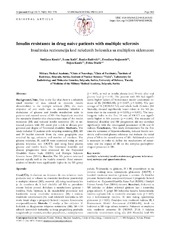| dc.creator | Kostic, Smiljana | |
| dc.creator | Kolić, Ivana | |
| dc.creator | Raičević, Ranko | |
| dc.creator | Stojanovic, Zvezdana | |
| dc.creator | Kostić, Dejan | |
| dc.creator | Dinčić, Evica | |
| dc.date.accessioned | 2018-03-01T17:41:56Z | |
| dc.date.available | 2018-03-01T17:41:56Z | |
| dc.date.issued | 2017 | |
| dc.identifier.issn | 0042-8450 | |
| dc.identifier.issn | 2406-0720 | |
| dc.identifier.uri | https://vinar.vin.bg.ac.rs/handle/123456789/1626 | |
| dc.description.abstract | Background/Aim. Due to the fact that there is a relatively small number of data related to systemic insulin abnormalities in the multiple sclerosis (MS), the main objective of our study was to determine whether a dysbalance of glucose and insulin metabolism exist in patients with natural course of MS. Our hypothesis was that the metabolic disorder that characterizes state of the insulin resistance (IR) and reduced insulin sensitivity (IS) in untreated patients with MS could play a role in disease progression and degree of functional disability. Methods. The study included 31 patients with relapsing-remitting (RR) MS and 14 healthy controls from the same geographic area matched by age, ethnicity and number of smokers. The glucose tolerance, IS, and IR were examined using an oral glucose tolerance test (OGTT) and using basal plasma glucose and insulin levels. The functional disability and disease progression were evaluated by the Expanded Disability Status Scale (EDSS) and Multiple Sclerosis Severity Score (MSSS). Results. The MS patients tolerated glucose equally well as the healthy controls. Basal concentrations of insulin were significantly higher in the MS group p LT 0.05), as well as insulin plasma level 30 min after oral glucose load (p LT 0.01). The patients with MS had significantly higher values of homeostasis model assessment indexes of IR (HOMA-IR) (p = 0.027; p = 0.028). The percentage of IS (HOMA2 % S) and whole body IS index (ISI Matsuda) showed significantly lower values in the MS patients than in the controls (p = 0.005; p = 0.001). The insulinogenic index in the first 30 min of OGTT was significantly higher in MS patients (p = 0.005). The measures of functional disability and MS progression did not correlate significantly with the investigated parameters of IR and IS indexes. Conclusion. This study demonstrates for the first time the existence of hyperinsulinemia, reduced insulin sensitivity and normal glucose tolerance that indicate the initial phase of IR in the natural course of MS. Additional research is necessary in order to define the mechanisms of occurrence and the impact of IR on the complex pathophysiological processes in MS. | en |
| dc.rights | openAccess | en |
| dc.source | Vojnosanitetski pregled | en |
| dc.subject | multiple sclerosis | en |
| dc.subject | insulin resistance | en |
| dc.subject | glucose tolerance | en |
| dc.subject | test | en |
| dc.subject | surveys and questionnaires | en |
| dc.title | Insulin resistance in drug naive patients with multiple sclerosis | en |
| dc.type | article | en |
| dc.rights.license | ARR | |
| dcterms.abstract | Костиц, Смиљана; Колић Ивана; Динциц, Евица; Костиц, Дејан; Стојановиц, Звездана; Раицевиц, Ранко; | |
| dc.citation.volume | 74 | |
| dc.citation.issue | 6 | |
| dc.citation.spage | 563 | |
| dc.citation.epage | 570 | |
| dc.identifier.wos | 000404647700008 | |
| dc.identifier.doi | 10.2298/VSP160218082K | |
| dc.citation.rank | M23 | |
| dc.type.version | publishedVersion | |
| dc.identifier.scopus | 2-s2.0-85020770401 | |
| dc.identifier.fulltext | https://vinar.vin.bg.ac.rs//bitstream/id/11979/1622.pdf | |

